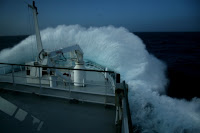N51, W34. Water 9C, Air 6C. Wind F2-F3 northerly, Swell 3-4m. Ship speed 10 knots.
Today we had our very own special time zone (GMT +0.5) as we tried to catch up with GMT gradually. But as of lunch time we are on GMT (a bit prematurely, giving dark mornings but 'summer' evenings).
 |
| Fulmar over our wake yesterday morning (Conor Ryan) |
Conditions were ideal for watching from dawn till dusk today with complete cloud cover (preventing glare), visibility of >15km and sea state 2 to 3 and no showers. There were noticeably fewer birds today, however we had s surprising visitor - a 3rd winter great black backed gull that appeared to have an injured leg(s). It was unable to stand and spent the day sleeping on the bow (catching the attention of the odd passing skua). For a coastal species, the Mid-Atlantic Ridge is not a good place to be with an injury I imagine, maybe it will stay on board until we reach the Irish coast.
There were several great skuas today, kittiwakes, a single gannet (lost? but with a purposeful westerly flight), Brunnich's guillemot, puffin and little auks.
 |
| Great Black Backed Gull tending to it's dodgy leg on the bow of Celtic Explorer |
There were 7 cetacean sightings, however 6 of these were made in the last hour as we approach the Mid Atlantic Ridge. One pod of 12 patterned dolphin species (most likely to be striped dolphin) were spotted early on in the day avoiding the ship about 3km distant. After dinner a pair of sperm whales were seen moving out of the way of the ship and then logging on the surface - this was the first sighting of sperm whales despite them being heard regularly on the hydrophone (not surprising considering their capacity to stay under for up to an hour at a time).
 |
| Immature Glaucous Gull seen yesterday, none observed today (Conor Ryan) |
An hour before sunset we hit an aggregation of fin whales - 5 sightings of 7 individuals. These were lunging on the surface, some even taking half-breaches. Being so high up on the crow's nest gave some great views of the lunge-feeding in motion - a side-ways lunge to the right, the tail constantly fluking and circling in a clock-wise circle before lunging again. There may have been a sei whale amongst the fins, but the fading light made species ID tricky. The MAR is a well known location for sei whales.
 |
| Fin Whale lunge-feeding, note the white lower jaw. It is unusual to get an 'upright' lunge like this (Conor Ryan) |
 |
| Upper jaw of a fin whale lunge-feeding. Western slopes of the Mid-Atlantic Ridge. (Conor Ryan) |
The hydrophone picked up sperm whales (10 detection events, mostly in groups) and pilot whales (3 detection events) as well as unidentified dolphins (5 detection events) today. We are picking up plenty of radio interference (the crew were wondering what language the sperm whales were speaking last night as they unexpected heard voices in the dry lab). Some of the voices were very excited and speaking about soccer (Alessandro is not gone mad from monitoring the PAM, I swear).
So tomorrow we will be on the MAR proper, heading down hill again by first light, across some more abyssal plain and then over the East Thulean Rise and the Porcupine Bank in the following days. Lets hope the weather continues to stay favourable, we've been very lucky so far and feels more like the Irish Sea than the Mid Atlantic!
 |
| View aft from the crow's nest yesterday in a following wind. |







































